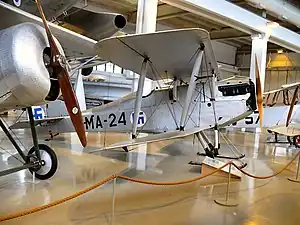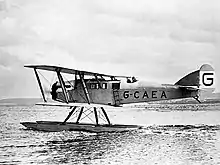| F.4 Buzzard | |
|---|---|
 | |
| Martinsyde Buzzard in the Aviation Museum of Finland | |
| Role | Biplane fighter |
| Manufacturer | Martinsyde |
| Designer | George Handasyde |
| First flight | June 1918 |
| Retired | 1940, by Finland[1] |
| Primary users | Royal Air Force Soviet Air Force |
| Number built | ~370[2] |
The Martinsyde F.4 Buzzard was developed as a powerful and fast biplane fighter for the Royal Air Force (RAF), but the end of the First World War led to the abandonment of large-scale production. Fewer than 400 were eventually produced, with many exported. Of particular note was the Buzzard's high speed, being one of the fastest aircraft developed during World War I.[3]
Design and development
In 1917, George Handasyde of Martinsyde designed a single-seat biplane fighter powered by a Rolls-Royce Falcon V-12 engine, the Martinsyde F.3, with a single prototype being built as a private venture without an official order, and had flown at Brooklands aerodrome by October 1917.[4] six being ordered in 1917, with the first flying in November that year. Its performance during testing was impressive, demonstrating a maximum speed of 142 mph (229 km/h),[5] and was described in an official report as "a great advance on all existing fighting scouts",[6] resulting in an order for six pre-production aircraft and 150 production fighters being placed late in 1917.[7] It soon became clear, however, that all Falcon production was required to power Bristol F.2 Fighters, so an alternative to the Falcon would be needed.[8]
Martinsyde designed a new fighter based on the F.3, but powered by a 300 hp (220 kW) Hispano-Suiza 8 engine, the F.4 Buzzard. The Buzzard, like the F.3, was a single-bay tractor biplane powered by a water-cooled engine. It had new lower wings compared with the F.3, and the pilot's cockpit was positioned further aft, but otherwise the two aircraft were similar. The prototype F.4 was tested in June 1918, and again demonstrated excellent performance, being easy to fly and maneuverable as well as very fast for the time.[9] Large orders followed, with 1,450 ordered from Martinsyde, Boulton & Paul Ltd, Hooper & Co and the Standard Motor Company. It was planned to supply the French Aéronautique Militaire as well as the British Royal Air Force, and production of a further 1,500 aircraft was planned in the United States of America.[10]
Deliveries to the RAF had just started when the Armistice between the Allies and Germany was signed. Martinsyde was instructed to only complete those aircraft which were part built, while all other orders were cancelled. The Buzzard was not adopted as a fighter by the post war RAF, the cheaper Sopwith Snipe being preferred despite its lower performance.[11]
Martinsyde continued development of the Buzzard, buying back many of the surplus aircraft from the RAF, and producing two-seat tourers and floatplanes. After the bankruptcy of Martinsyde in 1922, these aircraft were obtained by the Aircraft Disposal Company which continued to develop and sell F.4 variants for several years.[12]

Operational history
Despite the limited production, four of the six Martinsyde F.3s ordered were issued to Home Defence squadrons of the RAF in 1918, with two being operated by No. 39 Squadron RAF on 8 July 1918[6] and one used by 141 Squadron.[13] The RAF received 310 F.4 Buzzards before the end of the First World War, but only 57 would be used. In the immediate post war period, two Buzzards were used as high speed communications aircraft in support of the British delegation at the Paris Peace Conference in 1919, while a few other Buzzards were used at the Central Flying School.[14][15]
While the postwar RAF was not buying Buzzards, Martinsyde had some success selling them overseas, with both single and two-seat versions being sold to a number of air forces, including those of Spain (20 aircraft),[16] Finland (15 aircraft)[1] and the Soviet Union (41 aircraft).[1] Some of these aircraft had long careers, with six of the Spanish Buzzards remaining in service at the start of the Spanish Civil War.[17] Following the bankruptcy of Martinsyde, the Aircraft Disposal Company sold eight Jaguar engined versions, the ADC.1 to Latvia, one of these remaining in service until 1938.[18]
Other Martinsydes were sold to civil owners for use as tourers, racing aircraft, and in Newfoundland, for survey flights and seal spotting.[19]
Variants
- F.3
- Single-seat fighter biplane. Powered by Rolls-Royce Falcon. Seven built.[13]
- F.4 Buzzard
- Single-seat fighter biplane. Powered by 300 hp (220 kW) Hispano-Suiza 8 engine. Main production type.
- F.4 Buzzard 1a
- Long range escort fighter for Independent Air Force; three built.[14]
- F.4A
- Surplus F.4 Buzzards converted into two-seat aircraft for touring and military use.
- F.6
- Surplus F.4 Buzzards converted into two-seat aircraft; revised wing and landing gear.[20]
- F.16
- Soviet two-seater derived from F.4, 20 built.[1]

- Type A.Mk I
- Surplus F.4 Buzzards converted into two-seat long-range aircraft. Larger two-bay wings, powered by Rolls-Royce Falcon engines.[21]
- Type AS.Mk I
- This version of the Type A.Mk I was fitted with float landing gear.[21]
- Type A.Mk II
- Four-passenger cabin version of A Mk.I. Powered by Hispano-Suiza or Falcon engine.[21][22]
- A.D.C. 1
- Single-seat fighter version, powered by a 395 hp (295 kW) Armstrong Siddeley Jaguar radial piston engine. The aircraft was developed by the Aircraft Disposal Company.[23] One prototype.[24] Eight production aircraft were exported to Latvia.[18]
- Nimbus Martinsyde
- One aircraft was converted by A.D.C. with a 300 hp (220 kW) ADC Nimbus engine.[18][25]
- A.V. 1
- One aircraft built for the engine designer Amherst Villiers, painted two-tone blue and white, and nicknamed the Blueprint.[18]
- Raymor
- a single A.Mk 1 modified for a transatlantic flight attempt, powered by a 285 hp (213 kW) Rolls-Royce Falcon III.
Operators
- Royal Canadian Air Force – One F.6 was in service with the RCAF in 1922.[26]
- Finnish Air Force – received one F.4 in 1923 and 14 in 1927, all ex-RAF machines, and operated them until 1940.[1] The sole surviving example is preserved at the Aviation Museum of Central Finland.[27]
- Aeronautique Militaire – One F.4 for evaluation.[28]
- Irish Air Service – Operated one A Mk.II (purchased in November 1921 so Michael Collins could escape to Ireland if Anglo-Irish Treaty negotiations broke down),[29][30] and four ex-RAF F.4 fighters.[18]
- Imperial Japanese Army Air Service – one F.4 was demonstrated to the Japanese.[1]
- Latvian Air Force – operated one F.4 and nine A.D.C.1s.[18]
- Lithuanian Air Force – money raised in the US by Lithuanian emigrants purchased two Buzzards in 1922, named Amerikietis (American man) and Amerikiete (American woman).[31][18]
- Polish Air Force – one F.4 used 1923–1926 as personal machine of Air Force Commander Włodzimierz Zagórski, in red and white stripes.[32]
- Portuguese Air Force – one F.4 being used for a sales tour was purchased and donated by British expatriates in Portugal, and three additional ex-RAF surplus F.4s were purchased by the Portuguese government.[20]
- Spanish Republican Air Force – operated a mix of 20 F.3s, F.4s and F.6s.[33]
- Spanish Republican Navy operated 13 aircraft including many transferred from the Air Force.[1]
- Soviet Air Force – received 41 ex-RAF F.4s from the UK, and produced an additional 60 or so F.4s in Russia, plus 20 two-seat F.16s.[1]
- Escuela Militar de Aeronautica – operated a single F.4.[18][28]
Specifications
Data from War Planes of the First World War: Volume One Fighters.[17]
General characteristics
- Crew: One
- Length: 25 ft 5.6 in (7.762 m)
- Wingspan: 32 ft 9.4 in (9.992 m)
- Height: 8 ft 10 in (2.69 m)
- Wing area: 320 sq ft (30 m2)
- Empty weight: 1,811 lb (821 kg)
- Gross weight: 2,398 lb (1,088 kg)
- Powerplant: 1 × Hispano-Suiza 8Fb inline engine, 300 hp (220 kW)
Performance
- Maximum speed: 146 mph (235 km/h, 127 kn) at sea level 132.5 mph (213.2 km/h) at 15,000 ft (4,600 m)[15]
- Endurance: 2.5 hours[15]
- Service ceiling: 24,000 ft (7,300 m)
- Climb to 10,000 ft (3,000 m): 7 min 55 sec
Armament
- Guns: 2 x 0.303 in (7.7 mm) Vickers machine guns
See also
Aircraft of comparable role, configuration, and era
Related lists
References
Notes
- 1 2 3 4 5 6 7 8 Bruce, 1999, p.29
- ↑ Holmes, 2005. p 34.
- ↑ Bruce 1965, p.162. Note:"...one of the fastest then in existence."
- ↑ Bruce Air International July 1977, p. 28.
- ↑ Mason 1992, p.118.
- 1 2 Bruce 1965, p. 160.
- ↑ Bruce Air International July 1977, p. 29.
- ↑ Bruce Air International July 1977, pp. 30–31.
- ↑ Bruce 1965, p.162.
- ↑ Bruce 1965, p. 164.
- ↑ Mason, 1991, pp.137–138
- ↑ Bruce 1965, pp. 165–166.
- 1 2 Bruce Air International August 1977, p. 86.
- 1 2 Bruce 1965, p. 165.
- 1 2 3 Mason 1992, p. 138.
- ↑ Bruce, 1999, pp.28-29
- 1 2 Bruce 1965, p. 166.
- 1 2 3 4 5 6 7 8 Bruce, 1999, p.30
- ↑ Jackson 1988, pp. 28–34.
- 1 2 Bruce, 1999, p.27
- 1 2 3 Jackson 1988, p. 28.
- ↑ Flight 17 August 1922, pp. 463–465.
- ↑ Flight 27 November 1924, pp. 742–745.
- ↑ Jackson 1988, p. 33.
- ↑ Flight 3 June 1926, pp. 315–317.
- ↑ Jackson, 1988, p.31
- ↑ Suomen, Keski. "Ilmavoimien koneet vuodesta 1917 alkaen / Airplanes of FAF since 1917." Ilmailumuseo (Aviation Museum of Central Finland). Retrieved: 25 November 2008.
- 1 2 Bruce, 1999, p.36
- ↑ "Air Corps History." Archived 2008-12-22 at the Wayback Machine Irish Defence Forces. Retrieved: 25 November 2008
- ↑ "Air Corps Aircraft Register." Archived 2011-07-15 at the Wayback Machine IrishAirPics.com. Retrieved: 25 November 2008.
- ↑ Vistakas 1985, p. 63.
- ↑ Bruce, 1999, p.35
- ↑ Bruce, 1999, p.28
Bibliography
- "A Martinsyde for Newfoundland: The Type A Mark II, Sold to the Aerial Survey Company". Flight, 17 August 1922, pp. 463–465.
- "Another Interesting A.D.C. Modification: The 'Nimbus-Martinsyde'." Flight, 3 June 1926, pp. 315–317.
- Bruce, Jack M. (July 1977). "From Pachyderm to Bird of Prey: Part 1". Air International. Vol. 13, no. 1. pp. 25–32.
- Bruce, Jack M. (August 1977). "From Pachyderm to Bird of Prey: Part 2". Air International. Vol. 13, no. 2. pp. 82–86.
- Bruce, Jack M. (September 1977). "From Pachyderm to Bird of Prey: Part 3". Air International. Vol. 13, no. 3. pp. 131–137.
- Bruce, Jack M. (1999). Martinsyde Buzzard. Windsock Datafile. Hertfordshire, UK: Albatros Publications. ISBN 978-1902207179.
- Bruce, Jack M. (1965). War Planes of the First World War: Volume One Fighters. London: Macdonald.
- Green, William and Gordon Swanborough. The Complete Book of Fighters. New York: Smithmark, 1994. ISBN 978-0831739393.
- Holmes, Tony (2005). Jane's Vintage Aircraft Recognition Guide. London: Harper Collins. ISBN 978-0007192922.
- Jackson, A.J. (1988). British Civil Aircraft since 1919. Vol. 3. London: Putnam. ISBN 978-0851778181.
- Mason, Francis K (1992). The British Fighter since 1912. Annapolis, Maryland: Naval Institute Press. ISBN 978-1557500823.
- "The Martinsyde A.D.C. I Single Seat Fighter". Flight, 27 November 1924, pp. 742–745.
- Vistakas, C. (November 1985 – February 1986). "The Annals of Lithuanian Aviation". Air Enthusiast. No. 29. pp. 61–66. ISSN 0143-5450.